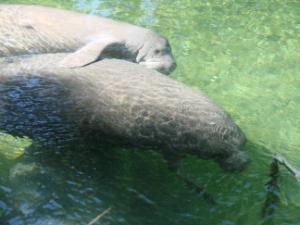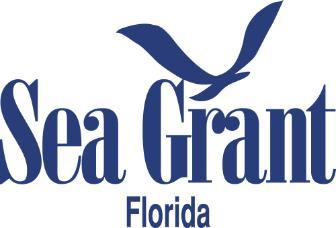3rd Grade Manatee Curriculum
This curriculum was designed in 2009-2010 by Drs. Maia McGuire and Ruth Francis-Floyd with assistance from Alexis Morris and Maxine Floyd. The lessons were reviewed and updated in 2014-15. The intent is to have 3rd grade teachers in Florida (and elsewhere) integrate these lessons into their regular curriculum, mostly in the fall semester, culminating with a field experience in December and a school manatee science night in the spring. Lessons are designed to take approximately one class period each (exceptions are noted in the lesson descriptions). Lessons are listed in the suggested order; however each is a stand-alone lesson that could be taught independently of the other lessons. Sunshine State Standards (science) and/or common core standards are provided for each of the lessons. Comments on the curriculum should be sent to Maia McGuire. Thanks to Nina Youngman and Kristi Booth for piloting some lessons for us and for providing feedback, and to all the Florida Sea Grant and UF/IFAS Extension faculty who reviewed materials and provided helpful suggestions for improvement.
If you have used any of these lessons, we'd love to get your feedback. Please take a few minutes to fill out a short online evaluation. Thanks!
Objectives: To learn about the biology and ecology of a manatee; to learn ways that humans impact and can protect manatees
An ALTERNATE SOURCE for the ENTIRE CURRICULUM can be found here. Supplemental materials for lessons 2 and 9 can be found through additional links below).
SEE or HEAR manatees online! During winter months, you can view manatees via live webcams at Blue Spring State Park. Archived videos are also available. Several different manatee calls are now available on the Save the Manatee Club website.
Outline:
Introduction to the curriculum (pdf 150 KB)
Lesson 1: Starting to learn about manatees
- Create a KWL chart (this will be referred to all year)
- Students will learn about manatee biology by reading the book, Sam the Sea Cow.
- DOWNLOAD LESSON (pdf 140 KB)
Lesson 2: Reading Rainbow Sam the Sea Cow
- Students will watch the Reading Rainbow program based on Sam the Sea Cow and will complete a worksheet.
- DOWNLOAD LESSON (pdf 159 KB)
- Sam the Sea Cow Teacher's Guide
Lesson 3: Manatee Adaptations!
- Students will learn about what an adaptation means and how manatees are adapted to their aquatic environment.
- DOWNLOAD LESSON (pdf 143 KB)
- DOWNLOAD LESSON 3 POWERPOINT PRESENTATION (11 MB)
Lesson 4: Manatees are mammals; they are closely-related to elephants
- Students will learn characteristics of mammals and will use observation skills to list similarities and differences between manatees and their close relative, elephants.
- DOWNLOAD LESSON (pdf 3.3 MB)
Lesson 5: There are many species of animals similar to manatees, living in different parts of the world.
- Students will learn about different species of Sirenians, and will use maps to locate where each species lives.
- DOWNLOAD LESSON (pdf 1.4 MB)
- FWC manatee activity book. You can also request printed copies of these from the Florida Fish and Wildlife Conservation Commission (850) 488-4676.
Lesson 6: What Do Animals Need to Survive?
- Students will attempt to hatch brine shrimp in water of different salinities to learn how changes in the environment affect survival of animals.
- This activity has three parts and will take approximately 2.5 class periods over a 1-week timeframe.
- DOWNLOAD LESSON (pdf 534 KB)
Lesson 7: What do Manatees Need to Survive?
- Students will learn about plant biology, herbivory and what manatees eat. Students will realize that all plants are not the same and the manatee has some that it prefers.
- DOWNLOAD LESSON (pdf 1.8 MB)
Lesson 8: How much do manatees need to eat?
- Students use math skills to calculate manatee feeding needs.
- DOWNLOAD LESSON (pdf 137 KB)
Lesson 9: Manatees need warm water to survive
- Students will understand thermal refuges and manatee winter migrations.
- You may want to spread the components of this lesson over two class periods.
- DOWNLOAD LESSON (pdf 669 KB)
- DOWNLOAD LESSON 9 POWERPOINT PRESENTATION (8 MB)
- Watch a video showing how to make a blubber glove
Lesson 10: Students will learn how they impact their environment.
- Students will learn that different activities create different amounts of pollution
- DOWNLOAD LESSON (pdf 137 KB)
- DOWNLOAD LESSON 10 POWERPOINT PRESENTATION (5 MB)
Lesson 11: Biodegradable or not?
-
Students will learn what types of items are biodegradable and what types are not.
-
This lesson requires two class periods about one week apart.
- DOWNLOAD LESSON (pdf 146 KB)
Lesson 12: Pollution and other threats to manatees
- Students will learn about threats to manatee survival
- DOWNLOAD LESSON (pdf 2.5 MB)
Lesson 13: Manatee Migration
- Students will learn about factors that can affect manatees in their migration to find warm water in the fall and winter months. Students will work together to complete a successful manatee migration.
- DOWNLOAD LESSON (pdf 186 KB)
Lesson 14: Reviewing what we know about manatees
- Students will use quizzes to test their knowledge about manatees
- DOWNLOAD LESSON (pdf 178 KB)
Lesson 15: Collecting data about manatees
- Students will learn how scientists identify and track individual manatees
- DOWNLOAD LESSON (pdf 1.1 MB)
Lesson 16: Sharing what we know about manatees
- Students create podcasts/PSA’s/posters to teach others about ways to protect manatees.
- This may take 2 or more class periods.
- DOWNLOAD LESSON (pdf 123 KB)
Lesson 17: Exploring the manatees’ habitat!
- Students will complete a field study activity at Blue Spring State Park.
- During winter months, you can view manatees via live webcams at Blue Spring State Park. Archived videos are also available. www.savethemanatee.org/savethemanateecam.html
- Teachers should review the field data sheets with the class within a few days of the visit and should review and complete their KWL chart.
- DOWNLOAD LESSON (pdf 314 KB)
Lesson 18: Let’s have a manatee science night!
- Students and teachers will prepare for Manatee Night.
- DOWNLOAD LESSON (pdf 134 KB)
Dr. Maia McGuire is the Florida Sea Grant Associate Direector for Extension and Education. Dr. Ruth Francis-Floyd is a UF/IFAS Extension Veterinarian.


